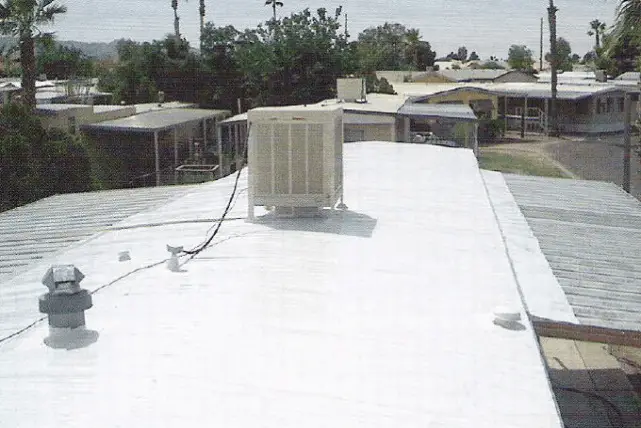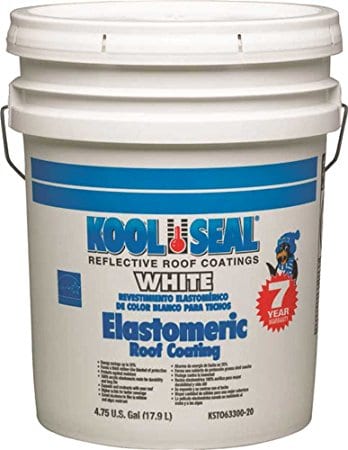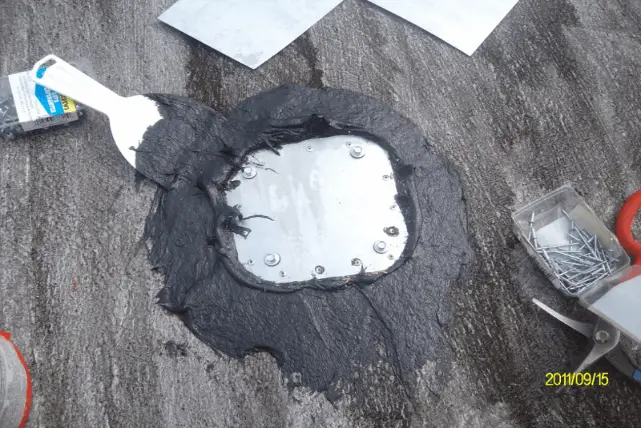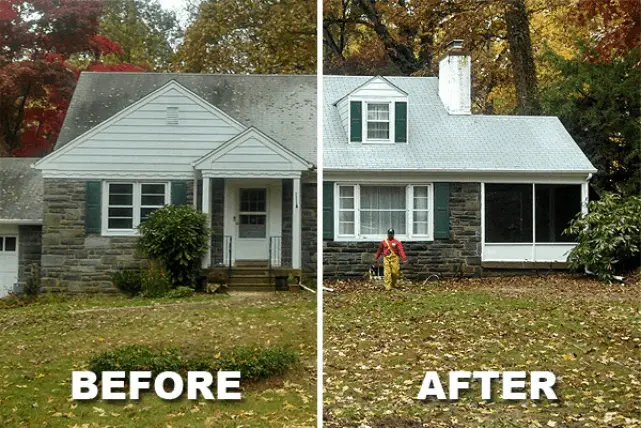
No matter where you live, it rains! Sometimes a lot, sometimes very little, but when it does rain, you want your mobile home roof to be watertight. Also, summers tend to be hot, humid and can generally heat up the roof to be hot enough to cook pancakes. Can popular roof coatings work to keep the water out and the heat off?
Table of Contents
Short Answer
Roof coatings are like a rubberized glue that gets “rolled on” the roof like paint. It helps seal cracks to keep out water leaks, and it’s also generally white, which reflects the heat off of the roof. It is one of the greatest and least expensive ways to extend the life of your roof; keeping your home dry and cooler.
Products
The seal coating that we like to use is “Kool Seal”. It is an acrylic elastomeric coating that is applied to the metal roof of a mobile home. It comes in 5 gallon buckets and is very easy to apply.
Kool Seal can be purchased at Walmart, Home Depot, or Lowes as well as online:
- Generally runs about $90 for 5 gallons
- Covers an area 400 to 500sf
- 7 year warranty
Kool Seal states:
“Formulated with 100% acrylic elastomeric resin. The coating forms a thick rubber-like blanket of protection that expands and contracts with roofs. It remains flexible from -30 deg. F. to 160 deg. F. for long-lasting protection and provides superior reflectivity to lower interior temperatures and save energy. Recommended for metal, concrete, foam, brick, flat and barrel cement tiles, and aged aluminum coatings. You must use Kool Seal Kool-Lastik Primer, model No. 34-600, if applying to the following surfaces: Built-up roofs, modified bitumen, bonded tar and gravel, rolled roofing, most other asphaltic surfaces, and in ponding water situations. Cured elastomeric film is mildew and algae-resistant. Soap and water clean up – while wet. Reflects 90% + of the sun’s rays and has energy savings up to 35%. Coverage: 80 to 100 sq. ft. per gallon, depending on surface. For use on a properly drained roof. Color: White. 7 year warranty.”

There are other products on the market, so do your research to see which one might work best for you. In Arizona, we are subjected to intense sun and heat, as well as violent rain downpours during the summer months. Kool Seal is a brand we trust and has worked well for our properties.
Best Practices
- Weather Forecast – The weather forecast should NOT call for rain for a couple of days. For best adhesion and results, the temperature should be over 50 degrees and lower humidity.
- Roof Inspection – Your roof may not currently be leaking, but that doesn’t mean that there are no cracks or other damaged areas on the roof. Do a complete check of the roof to find areas that need repairing.
- Clean The Roof – After the inspection, remove any flaking previous coatings. Pay close attention to areas around edges and vents. It is important to remove any loose areas of the coating so that the new elastomeric roof coating has something to bond to. This may involve scraping and cutting away some loose and flaking areas. Be sure to sweep the roof clean.
- Repairs – Use roof patching cement to repair any areas that need fixing. Home Depot, in particular, sells many brands that are specialized to a particular type of repair.SFGate tells us “Roof cement is a multi-purpose patching material and adhesive for repairing holes and leaks in roofs; fixing rust spots and joints in leaky gutters and metal trim, and stopping leaks in flashing around chimneys, valleys and coping. It also is used to glue down loose asphalt shingles and fill cracks in concrete. Roof cement is an emulsion of asphalt, refined mineral spirits, plasticizers, and non-asbestos reinforcing fibers. There are formulas for dry and wet surfaces.”

- Pressure Washing – Start by pressure washing the roof to be coated. Dirt and grime settle on the roof. If left dirty, the elastomeric coating will have difficulty properly bonding to the metal or shingles. Thoroughly pressure washing at the start will eliminate as much dirt as possible and enhance the bonding of the product to the roof. Be sure to allow the roof to completely dry before continuing.

- Coating The Seams – It is important that you coat with roof patch cement any seams. Use a paintbrush and roof patching cement. Be sure to overlap by at least an inch. The seams include:
- J-Rails – This is one of the most common places for leaks to occur. , around vents, When you get leaks here, the water will very likely run down the insides of your walls before you even know you have a leak causing significant damage. The j-rail runs all the way around the perimeter of the roof on a metal roofed mobile home. Since all of the water drains over to this area, the potential for leaks here is high.
- Roof Seams – This is where the metal roof panels join together. Heavy winds will often move the panels. Over time the seams between the panels can develop cracks or gaps inviting leaks.
- Flashing – Flashing will almost always be around any vents or stacks protruding from the roof. Be sure to coat all around the flashings.
- Coating The Roof – This is where it is important to follow the directions of the coating you are using. I know, I’m as guilty as the next guy at wanting to just do the work without reading the instructions, but hey, the job will turn out much better if you do. The coating should be applied with a paint roller to be able to control the coating. Generally, a gallon will cover about 100sf. Measure out a 10 x 10 area and then use a gallon for that area. This is the recommended thickness. don’t cheap out and put on a thin coating, or it won’t stand up to the elements. Don’t go too thick either, or the coating can dry out and crack, defeating the purpose.
- Sunlight Exposure – In like ours, Arizona, the sun can be intense. This will cause the life of the roof coating to be less than 7 years. We recommend coating every 2 to 3 years if you live in a sun-drenched location.
- Touch-Ups – Your roof may need touch-ups after heavy storms. Check your roof thoroughly a few times per year. If the coating has lifted or removed from an area, touch it up.
Related Questions
“How Can I Get Rid Of Dampness And Mold In My Mobile Home?”
Water and humidity in any home, site-built, modular, or manufactured can cause problems for any homeowner. In fact, water remediation (restoration) is a $210 BILLION dollar business in the United States. In case you’re wondering, that is A LOT!
When water gets trapped in spaces such as attics, walls, crawl spaces, carpets, wood subfloors, etc. mold can develop. Mold is a common health hazard and causes all types of respiratory issues.
Remember the old saying “an ounce of prevention is worth a pound of cure”? That is absolutely the case when it comes to getting rid of dampness and mold inside of a mobile home.
Most folks think that water damage inside of a home comes either from leaking plumbing or a leaky roof. While those are both true, that is only the beginning. Sealing out moisture, whether from the roof, windows, doors, floor, skirting or ground is necessary to prevent a buildup of dampness and mold. Keeping the moisture away, to begin with, is the ultimate weapon against the buildup of dampness and mold.
“What Is The Life Expectancy Of A Mobile Home?”
This is a great question and one that should be considered carefully before making a purchase of a mobile home. What are your plans for the home?
- Will you be living in it full time?
- Will it be a vacation home?
- Will it be an investment property to rent out?
- Are you buying an older home or a newer one?
Carefully consider your answers to these questions in making a decision about what type of mobile home you may want to purchase.
The U.S. Department of Housing and Urban Development (HUD) tells us that the manufactured homes built today have a life expectancy of 30 to 55 years; of course, depending on how well they are maintained. We feel this is a good estimate for the middle ground. In our experience, we have seen some homes even older than 55 years that are in amazing condition. We’ve also seen others that are less than 15 years old that seem ready to be scrapped.
This HUD estimate is a great starting point, but there are a number of other variables that affect the lifespan of the home other than just maintenance.
